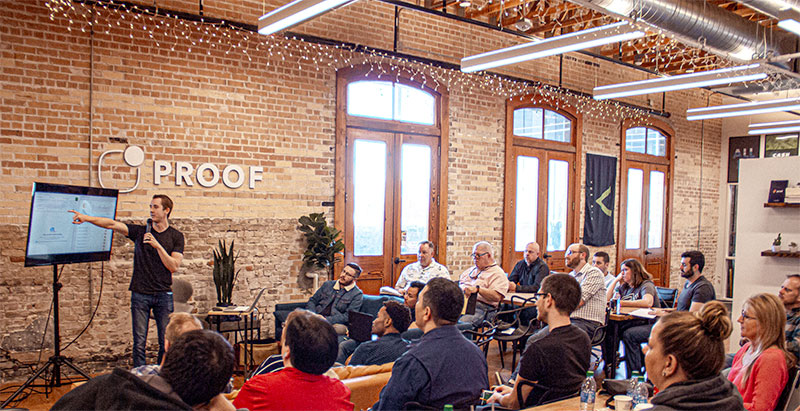
What Is With All the Pitching?
If you follow the world of Entrepreneurship and Startups, then you have likely seen countless discussions on the art of the Startup pitch. It might even seem like the only thing Startups actually do is conduct elevator pitches, compete in pitch competitions, and pitch to investors. And for good reason. It seems like most of the events and programs in the world’s ecosystems put a strong focus on these topics. In fact, the programming at Techstars, Y-Combinator, and every major accelerator in the world has a major component focused on pitch training in their programs.
So, the question remains, is pitching your idea in 30 seconds, 5 minutes, and 10 minutes really a requirement to being a successful Entrepreneur?
Of course not!
However, there is a method to the madness on why pitching is so important and why such a heavy emphasis is placed on it. If you want to launch a new venture, even if you don’t think you need investment, you need to learn to pitch. You need to become an expert in the art, and you need to practice on a daily basis. It really is crucial that you learn this at an early stage in your venture.
Here is Why Pitching is So Important
You’ve got a great idea, you’ve assembled a team, and you are working at break-neck speed to release your Minimal Viable Product (MVP). You listen to Masters of Scale and other awesome podcasts. You hang out with other Startups, attend events, and you read everything about building a company online. Is this not the path to success? No.
As a Startup Founder it’s easy to fall into the trap of learning instead of doing. Entrepreneurship is not something that can truly be learned by taking a class or reading a book. It has to be experienced. You can read everything about launching a venture, identifying your market, and you can spend countless hours building your products yet fail with all the new knowledge you’ve gained.
Believe it or not, this is where pitching comes in as your secret weapon.
Pitching is about doing. It’s about taking the crazy ideas in your mind and the vision of the future and putting it down in writing. Then you verbalize it. Most Startups struggle with this first step. Taking a vision and expressing it effectively is extremely difficult. All Founders go through this frustrating phase. Even experienced one’s struggle with this, even though they tend to hide it better!
When an Entrepreneur runs into trouble or difficulty, they tend to go around, over, or ignore the problem. Only when they are highly disciplined, or forced, do they double down and charge through the new wall in front of them. This leads to future problems, difficulty in finding co-founders as well as employees, an inability to rase capital, and often the company’s direction is lost.
The pitch fixes all of this. By taking an idea and vision and putting it down in writing, verbalizing it, and perfecting the delivery you are able to:
Inspire others to join your team as co-founders and employees
Effectively interview customers to gain valuable feedback
Create a compelling marketing pitch to customers
Sell your product to customers effectively
Raise funding from family, friends, angels, and venture capital
Inspire your team through difficult times through a shared vision
Without the pitch you are lost but you don’t know it… yet! But you will at an inopportune moment.
Why Do We Have to Do a 30s, 2min, or 5min Pitch?
It’s extremely common for a new Entrepreneur to attend an event and spend 5-10 minutes listing every single feature they are building into their product. It’s boring and doesn’t inspire anyone. It’s also exhausting to listen to multiple of these and causes those that might be interested to avoid future discussions.
You may love your idea but no one else does like you do, and no one has a chance to get excited about it in this approach.
The exercises of completing a pitch in multiple periods of time is extremely important. It forces a visionary to consolidate their ideas into what is most important. Then, as you expand your pitch in length you include more appealing insights to answer some of the common questions that will likely come up first in a discussion.
And let’s be realistic. You will never have someone approach you, ask for your 30 second elevator pitch and they will give you a check for $250k because they are so impressed. The goal for any pitch is to get the next meeting. It’s the start to a new relationship and not a quick and easy trick of the trade.
Instead, you will inspire others to learn more, connect you to their network and inspire others join you on your Startup journey. Most importantly, you’ll be able to talk about your new company in a way that doesn’t scare everyone off or put them to sleep!
Who Are You Pitching? Who is the Audience?
Another struggle when teaching Entrepreneurs to pitch is they constantly want to know who they are pitching to. This questions typically comes up because the Entrepreneurs have very different goals for their pitch than those helping them learn to pitch. Often, the Entrepreneurs want to cut straight to the sales pitch so they can get out and sell their products while programs push you to learn a generic pitch.
Cutting straight to the sales pitch is that it will not work. You must build any new pitch on top of a strong foundation of information. It’s easy for a Founder, especially a technical/engineering minded one, is that your products will sell based on the features you present to the customers. The idea is that customers buy what you do is actually a huge misconception around sales. And it makes logical sense to think this way.
“People don’t buy what you do; they buy why you do it and what you do simply proves what you believe.” – Simon Sinek
The reality is that customers buy why you do something. They “why” is the solution to the problem that helps you relate to the customers. They also make purchases based on trust and your ability to communicate that you understand their problems from their perspective is key to building this trust.
Let’s look at a couple examples of this:
Sales Scenario A:
Hello, my name is David and I work at Better Widgets, Inc. My product handles your business invoicing, scheduling needs, employee taxes, and even cleans your bathrooms automatically. We charge $200 per month and you are likely to spend $400 per month so this is a 50% savings on your existing solution. Do you want to purchase our solution today?
What Happens? Do they Buy?
Rarely! If they do, you likely spend a lot of time going back and forth discussing prices, training, and the difficulty for them to switch solutions. They also will question how long you have been around and will be around in the future.
At first, a sales pitch like this seems like a guaranteed sale. You sat down with a client, you told them what you do and listed the features, and you are undercutting their solution. Unfortunately, this fails way more than this succeeds.
The problem is that we often assume the cost the customer is paying for a solution is only financial. The reality is that changing systems (even paper and pencil) has a time, training, and learning curve cost associated. Other Entrepreneurs have given talks on this topic and have stated that your customers may need to see your solutions as 10x or 20x more valuable than their current solution in order to convert them to your customer.
Now as Entrepreneurs, we all assume our products are magical. But remember, your prospective customers rarely see your product this way.
They consider other important issues to them such as:
How much do I have to learn?
How much do I have to train my people?
Will this product be around in 1, 3, 5 years? Or will I have to change it all again later?
Is this product legit and should I give them my money?
If I need support will there be support?
How many accounts do I have to change?
Notice, this isn’t a discussion on features, costs, etc. These other issues are more important and only when you solve these do you get to discuss price, features, and other aspects of the solution.
Let’s try this again:
Sales Scenario B:
My name is David and I’m the Founder at Better Widgets, Inc. I know how difficult it is to run a Widgets company! You lose countless hours scheduling your staff, it’s difficult to know where your deliveries should go next, and managing inventory takes up half your day! This isn’t why you got into Widgets!Our new platform helps you regain your time, it automates much of the work, and it helps you provide an incredible experience for your customers. When you use Better Widgets, you get back what is most important, time. This is time to do what you do best, work with your customers.
Why is this different?
This scenario focused on discussing the problems they face from the customers point of view. Telling them features is what YOU think they want. They don’t want features. They want solutions to their problems. They DO. NOT. CARE. How you solve the problem if you solve it.
You have made an emotional connection to your customer. You know what it’s like being them (you do, don’t you?) so you can talk about those hardships. When a customer stops you and says, “Oh and cleaning the bathrooms! That’s such a hassle!” you know you are on common ground with them as they are sharing a problem you should understand! This means they now feel comfortable with you to discuss additional problems.
You left room for questions. If you tell them everything, they will assume they know and understand everything and immediately go to ‘how much is this going to cost?’ When this happens early on in sales your messaging/approach is failing. You also are relying on their assumed knowledge which can also be dangerous.
You provided a vision for them to get behind. You don’t want them asking, if they should use your solution. You want them thinking, ‘If this product is this good, I really have to be using it!’ They want to believe you have their back, you are the best solution to their problems, and the start of a great relationship. This holds true even if you are selling online and not in person.
Think about a software product you use every day. If it fails, you likely feel betrayed by the company! When you get fed up and you switch to a different product, you feel like you are ’sticking it to them’. This strong of a reaction only happens because that company created trust, you bought into their vision, and you now feel betrayed in the relationship you formed with that solution.
This is what you need to create if you are going to sell to customers effectively. How are you going to do this with a feature listing? You better start learning to Pitch!
Why Aren’t We Building a Sales Pitch?
I get it, you really want to do a sales pitch! And you feel like we should start building that pitch immediately. But you’ve got some additional barriers in your way that you have yet to identify.
Getting to the table to be able to sell is the first problem
If you are in a room full of people, how do you connect with the ones that want your solution or know someone who does? The age-old, “It’s not what you know it’s who you know,” comes to play in these solutions. Each person you talk to about your business is a pitch and an opportunity to make a connection that can change the future of your business forever. You must learn to speak in a way that gets to this information quickly and concisely.
How do you attract customers to you? How do you attract the press to write stories about you? Each story is free advertising for your company. How do you inspire strangers to want to work for your company? Hiring is a difficult process and very competitive. And how does a person in the crowd know you are a solution for them or someone they know? You Pitch to Them All!
You have to stay generic enough to attract a variety of attention to maximize the possibilities for your Startup’s success. Not every moment is a customer sale, but it is a chance to build success in multiple ways. Then you can focus on potential customers, connections, and hires to inspire a positive outcome. As a Founder, it is key that you can do this effectively everywhere you go. Opportunity is always lurking around the corner if you know how to find it.
You aren’t ready yet!
You need to be able to talk about your company in a smooth, efficient way. You need to identify your customers, so you discuss their problems by talking to them in their own language. You don’t sell to a market segment, a company, or an online community. You are always selling to individuals that have their own worries and concerns that are different than your own. You need to learn these, understand these, and walk a mile in their shoes to effectively connect to them. Once you can do this, you can easily focus your generic pitch into a sales pitch that will knock their socks off and open their Apple Pay wallets!
Here is Our Strategy:
FoundersForge built our program on top of multiple world-class programs around the United States. Our founding board brought together the best programming they had experienced while attending Google NEXT for Entrepreneurs, Atlanta Tech Village’s programming, Chattanooga’s GigTank, and the awesome material provided by Techstars. We have combined the information and experiences we gained into a scaled down approach for early-stage Startups to follow.
We start by focusing on teaching you to attract people to your company
The generic pitch is focused on your core messaging. In a short period of time, you’ll hit a moment where it clicks. When it does, you will notice that you are able to attract the right kind of attention and people are eager to learn more about your venture, make a connection for you, or they will identify as potential customers.
Next, we focus on defining who your first customers really are
Remember, if you build a product, they will not come! You have to go out and get customers, investors, employees, and you can only do this effectively when you know who they are. Segmenting your potential customer base into an achievable target market will help you craft your messaging, understand your customers, and even sell effectively. It’s difficult to sell to everyone and much easier to focus on one type of customer.
Last, we help you learn to talk to your potential and current customers effectively
Customer interviews at an early stage are not about features. It’s about understanding their problems, understanding what they do, and being able to speak your customer’s language. Spending a day in your customers shoes by job shadowing, volunteering, or even working for a customer can pay off quickly. When you can’t do these things, interviewing your customers is the next best thing to do. However, you must do this the right way. By focusing on learning, not selling, you can get to the root understanding of the problems your customers face. Then you can build an effective solution.
Now You Are Ready to Expand and Develop Your Full Pitch
All the work on the early elevator pitch will help guide you to through this process. Again, focus on the problem, your ‘why’, and talk about your solution in terms of how it solves the problem instead of listing features. Then focus on which customers our solutions work best for. And we bring it home with a simple but clearly stated ask.
FoundersForge heavily subscribes to Kevin Sandlin’s approach to pitching. Kevin ran Atlanta Tech Village’s weekly Pitch Practice sessions for many years and wrote the book:
“Practice Your Pitch: 21 Lessons from 2500 pitches from leading entrepreneurs at Pitch Practice.”
This is a must-read book for any new Entrepreneur and will help guide you early on in your pitch. It’s also a great read to remind any experienced Entrepreneur how to perfect their pitch for later stage growth purposes.
 Buy Now on Amazon.com Buy Now on Amazon.com |
Kevin’s strategy is simple: Step 1: Your Name |
By following these steps and carefully focusing on each one, you will begin pitching better each time you practice. Make sure you write down your pitch and then say it 100 times. Practice in the car on the way to work, meetings, and anytime you are board. Say it out loud, not just in your own head. Time it, record it, and say it to anyone who will listen. Watch listeners carefully and learn where you are capturing their attention as well as when you lose them.
This is Why We Pitch
Remember, learning this skill can be a fun experience if you slow down and put some time into it. Every time you can pitch you have a chance to get better, make a connection, and move your company forward. This is an extremely important skill you should practice often and perfect. Even if you don’t pitch, attend a competition like Pitchers and Pitches. Watch how others pitch and learn from their experience. But don’t forget, Entrepreneurship isn’t something you can learn without experiencing it.
So, get out and get the experience you need to succeed!





